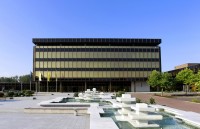Dieser Computer stammt aus der GEMINI-2 Mission. Er war am 19.01.1965 auf einem unbemannten Flug im All.
Die Raumfahrtprogramme Mercury und GEMINI schufen die Voraussetzungen für die Mondlandung. Die GEMINI-Missionen erprobten ab 1963 Kopplungsmanöver der Raumkapseln im All. Sicheres und zielgenaues Manövrieren konnte nur mit Hilfe des Computers gelingen.
IBM erhielt den Auftrag zur Entwicklung des Bordrechners für 26,6 Millionen US$.
Das Gerät hatte erstmals einen Kernspeicher, der Daten bei der Auslesung nicht zerstörte. Es ist außerdem der erste Computer von IBM, der ganz mit Siliziumtransistoren bestückt war. Der Rechner funktionierte störungsfrei.
en

